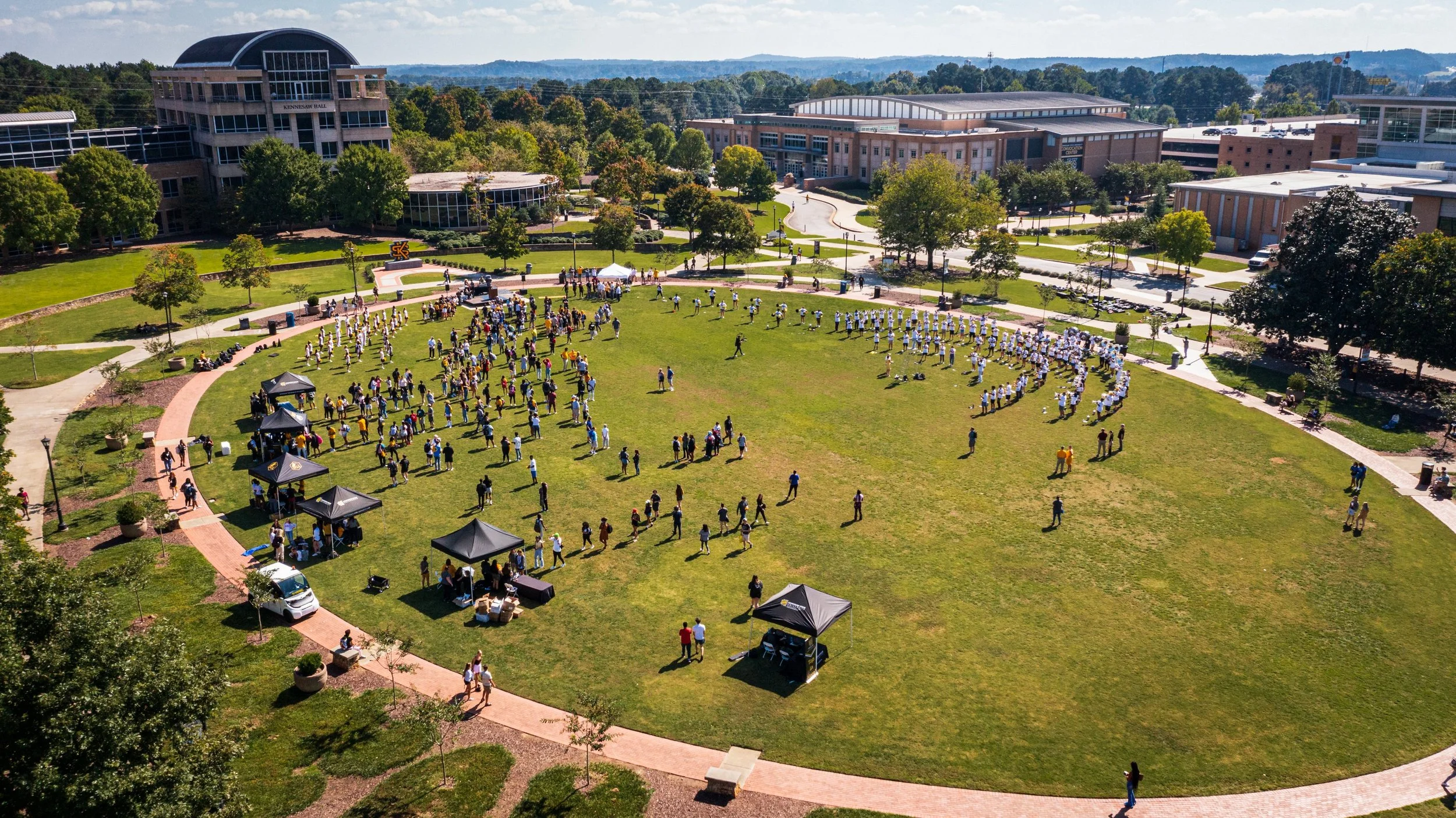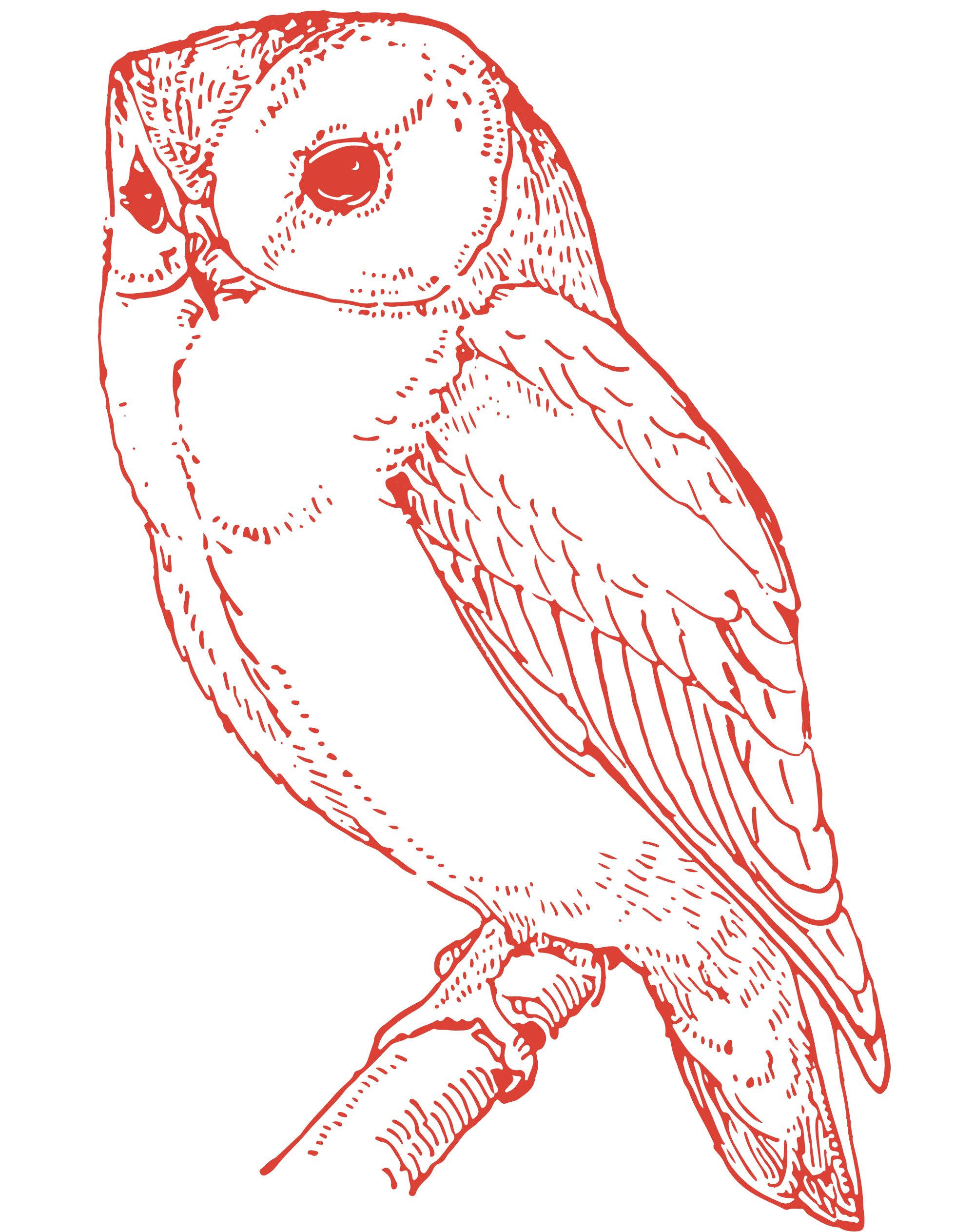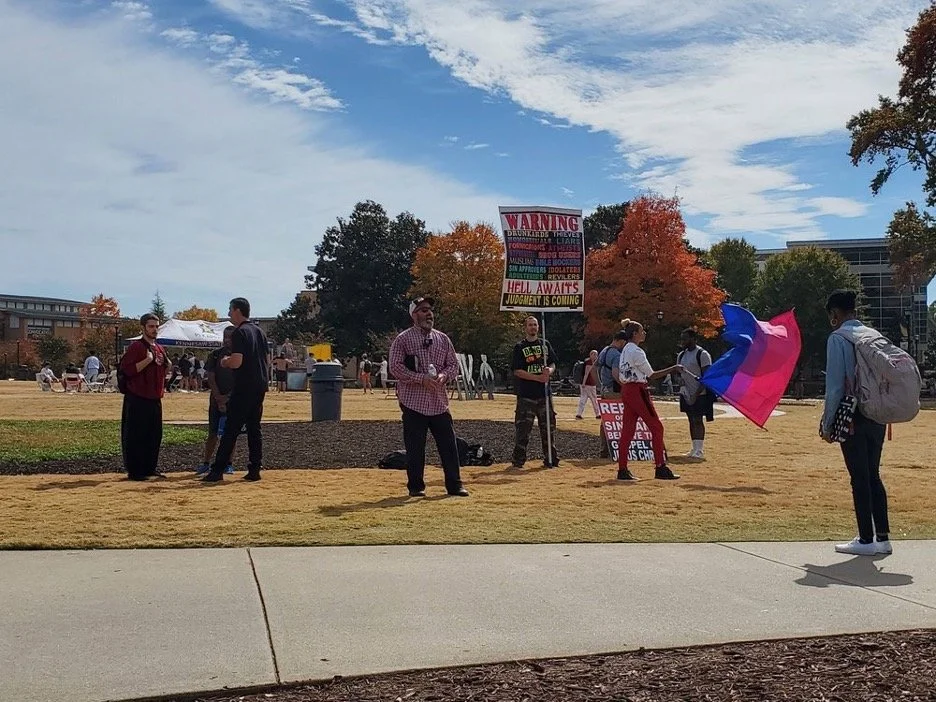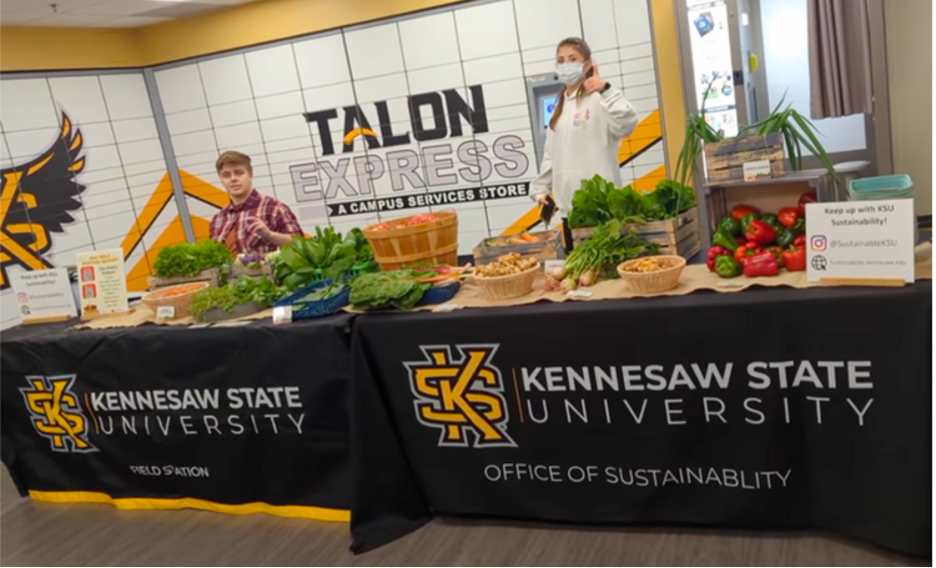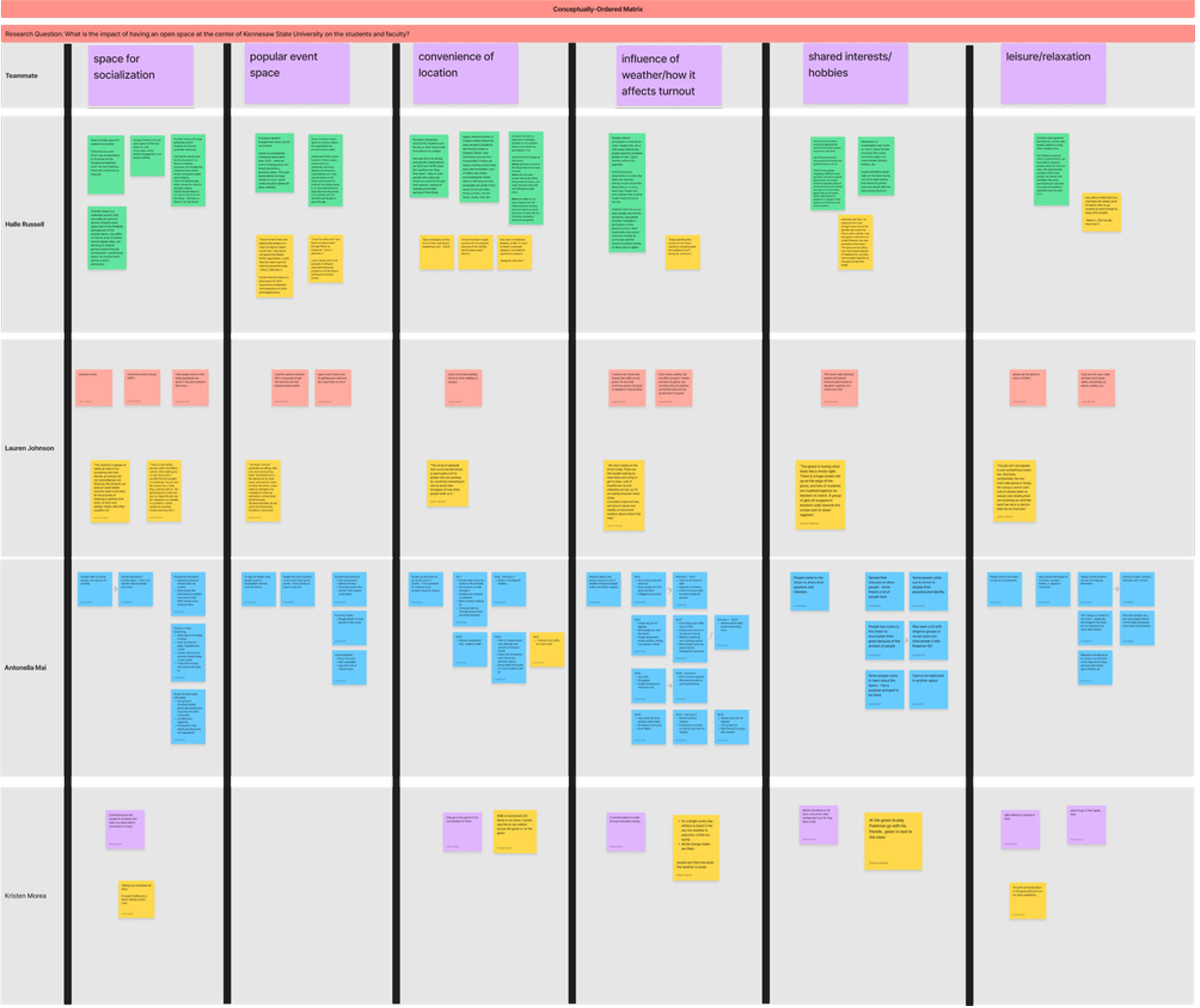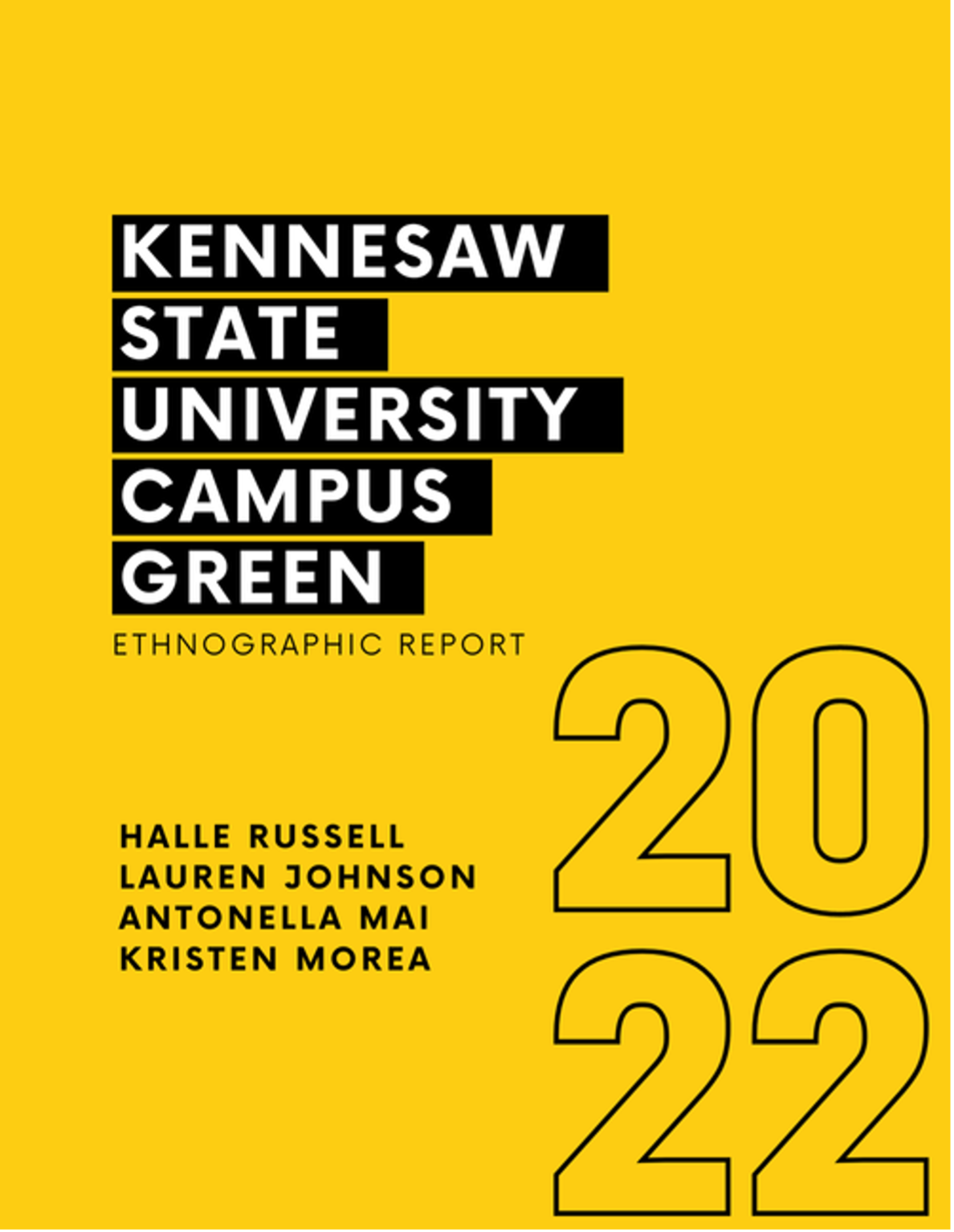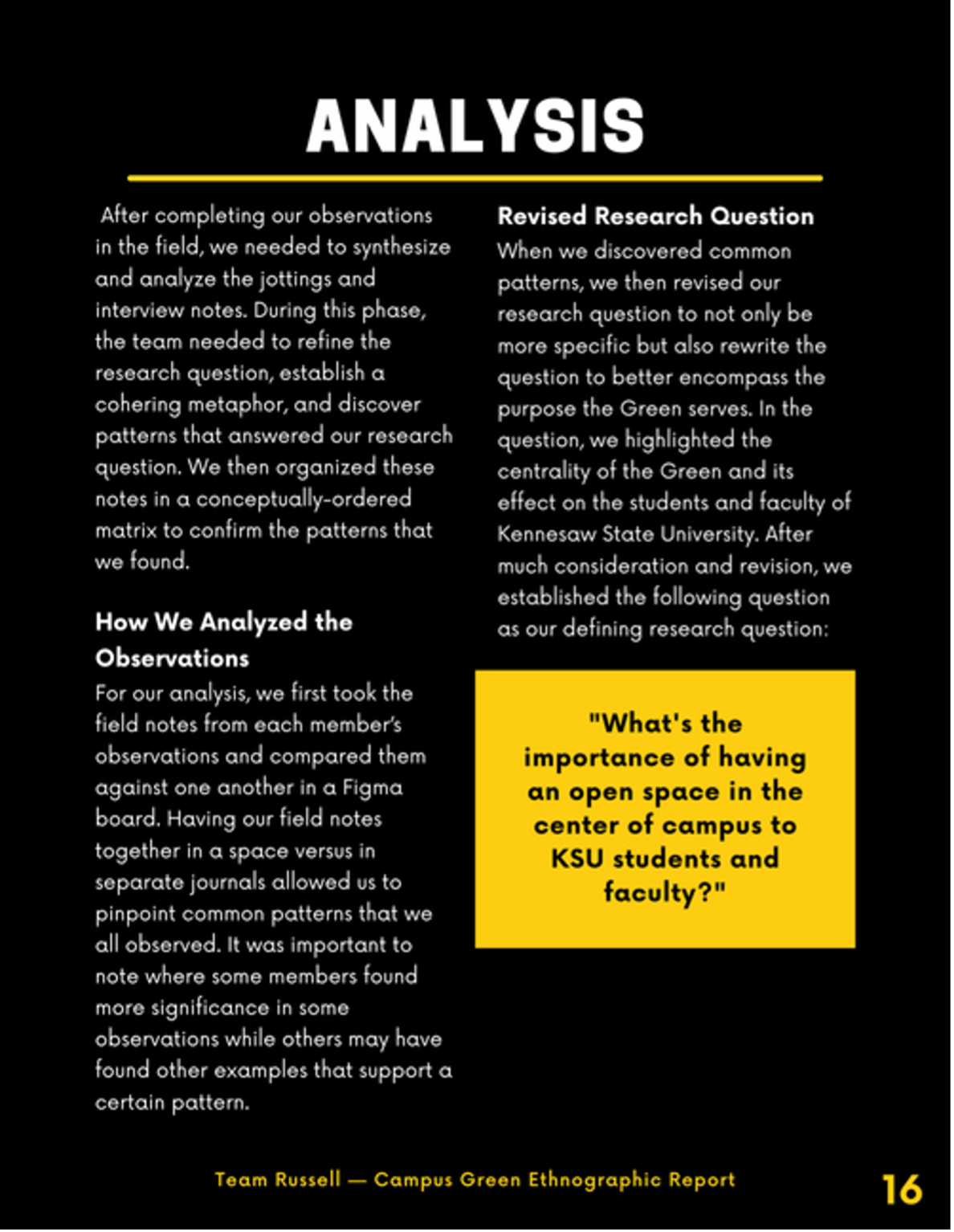Ethnography Study: The Campus Green
An ethnography study resulting in a research report done of the Kennesaw State Campus Green.
Executive Summary
During the Fall Semester of 2022, my team and I worked through the process of Applied Ethnography to better understand the importance of having green spaces on college campuses. Applied Ethnography is the act of observing and analyzing a specific field in order to understand the people within said field and their culture. The field we studied in was located on Kennesaw State’s Campus Green, and our research question was modeled down to the specifics of this certain field, “What does having a space like the Campus Green mean to you?”
After long hours of observing and researching, we then designed a cohering metaphor to describe what the campus Green is like: “The Campus Green is a blank canvas in a museum of university culture”
Approach
Applied Ethnography
Role
Ethnographer, writer, interviewer, researcher
Tools
FigJam, Discord, Google Docs, Canva
Duration
September 2022 - November 2022
Research Report (link to PDF)
Figjam Workspace (link to Campus Green-related research process)
Links
Gaining access to a field, difficulty in finding participants to interview, schedule conflicts between team members, weather
Challenges
Our team concluded from the analyzation of all our data that there were multiple patterns found in why people come to the Green/why it is an important space to have. These patterns included:
Space for Socialization
Popular Event Space
Convenience of Location
Influence of Weather
Shared Interests & Hobbies
Leisure/Relaxation
These findings all came together to allow us to answer our Research question: KSU’s Campus Green is used for a variety of activities, acts as a place of socialization, and provides a space to take time for oneself. The Green is able to accommodate for all of this variety due to its location and abundance of empty space, which in turn attracts those present on campus.
Findings
Meet the Team
-
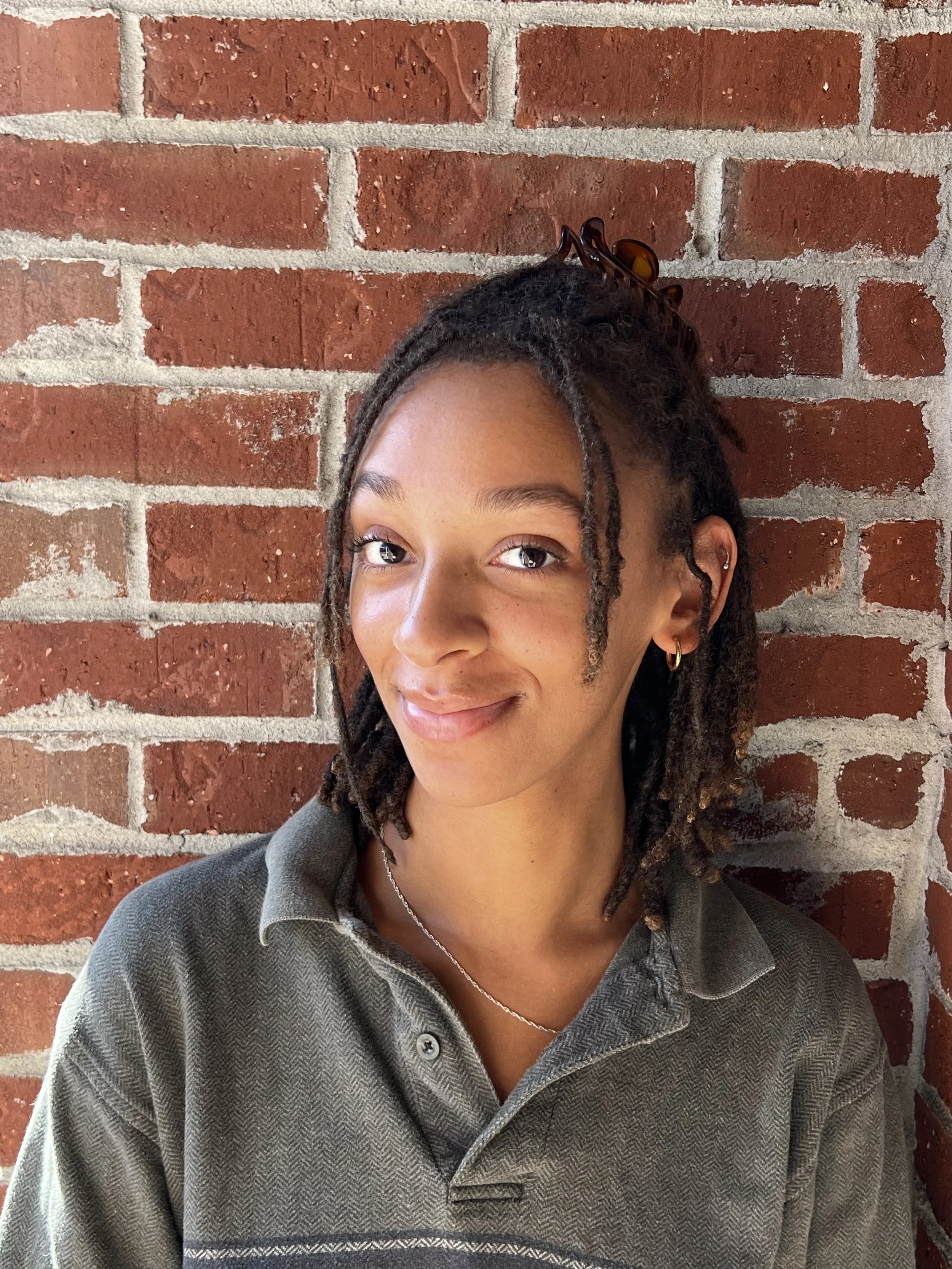
Halle Russell
TEAM LEADER
-

Lauren Johnson
ETHNOGRAPHER
-

Antonella Mai
ETHNOGRAPHER
-
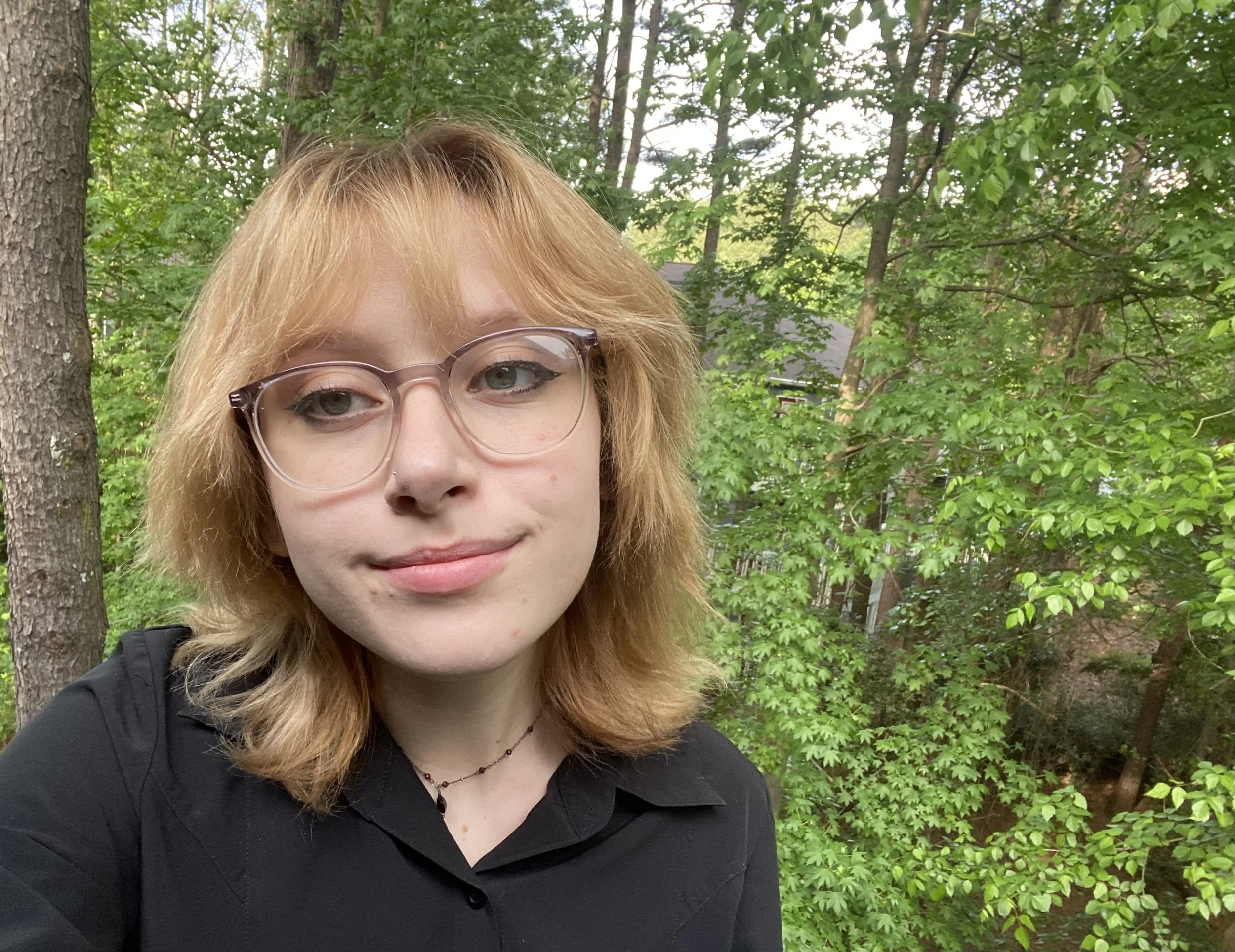
Kristen Morea
ETHNOGRAPHER
Introduction
The Campus Green: The center of Kennesaw State’s campus. Here one can find the rich culture that makes up this university, with clubs set up to recruit people, couples laid out on blankets in the grass, friends playing frisbee with each other, and those who are hurrying by to get to class.
It is here that we see how important it is for college campuses to implement green spaces for their students and staff members to congregate. People unwinding, studying, spending quality time with one another, enjoying the outdoors, things we all need in positive human development.
This project was part of the course Ethnography for Designers, instructed by Dr. Michael Lahey, and designed to cooperate with the concept of Applied Ethnography. At the beginning of the semester, we were tasked with pitching an idea to our class about a potential field to study in. After presenting, voting, and coming up with different teams, I was delighted to find out I had been placed within Halle’s team. I admired her views on sustainability, her leadership skills, and where we chose to study, so I was excited to get started.
The experience of people-watching on the Green is why our team of four ethnographers wanted to set out and answer the question of why this green communal space is important to students and faculty alike. We utilized a method of research known as “Applied Ethnography,” which is the study of “How people interact with each other and with their environment in order to understand their culture” (Eriksson and Kovalainen, 150). We then constructed a research question to answer our curiosities, “What does having a space like the Campus Green mean to you?”
My team and I all spent hours observing in our field to watch the events and actions that took place on the Green in order to better understand what drove people to come here. Each team member spent 10 hours observing/analyzing the field, for a total of 40+ collective hours spent on the Campus Green. After much analyzation and discussion, we as a team then came up with a cohering metaphor to help explain our answer: “The Campus Green is a blank canvas in a museum of university culture.”
Below you will find a more in-depth explanation of this project, including methodologies, recruitment, fieldwork, observation, interviews, analysis, report, and a conclusion.
Method
To begin this project, our team utilized the methodology of Applied Ethnography. As mentioned above, Applied Ethnography is the use of observation, note taking, and analyzation to understand how people operate with each other and their surroundings in a certain environment, which helps the ethnographers (researchers) understand the culture of this environment as well as a deeper understanding of the world in a broad sense. How does this differ from just ethnography? The key difference – applied ethnography is geared towards more private sectors.
Contextual research is another part of the methodology involved in ethnography, and my team and I conducted this kind of research by referencing/studying similar studies published on this topic. We also researched various effects on how public green space plays a role in human development/mental health. This contextual research allowed us as a team to have extra information to include within our report, making our research more solid and giving an outside perspective that we were not able to get personally.
Recruitment
Recruitment is an important aspect of applied ethnography because of the influence it can have on the quality of data collected from the field. If recruitment of a field is done with an inactive population, the data will be either inconsistent, inadequate, or both. Recruiting a field with large groups that meet frequently and stay active is incredibly important, as it will give you, the ethnographer, plenty of detailed data to work with moving forward.
When recruiting a field to study in our project, our team kept these thoughts in mind and made the decision to choose a field that was busy and occupied frequently.
A challenge my team and I faced was during this recruitment phase, as the Campus Green was not our original field of choice. Due to unforeseen circumstantial issues, the gatekeepers of our original field had to retract their consent to allow us to study there, leaving our team with no field. The Campus Green, however, was an idea given to us that we all decided was a great choice to allow us to resume our research.
Our team then set out to create a new research plan, complete with a new research question, schedule, and interview script in order to continue with our work. Since the Green is a public space at KSU, we had no gatekeepers from which to gain consent. . However, all interviewees required our consent, in which we obtained from all. Once this was all set and done, we made our way into the field.
Fieldwork
The process of fieldwork is involved and takes lots of time/dedication, but it is essential in the work of an applied ethnographer, as it allows the understanding of the culture, people, and the environment of that field. This step is pivotal if the ethnographer wants to build a thorough, detailed report based in truth. In our team, we were generally able to complete our fieldwork all together, as we had similar schedules. However, towards the end of our fieldwork timeline, we started to observe individually due to the chaos of the semester. I do not believe that this impacted our data negatively, as we were able to process thoughts and information in a new sense. My team and I would typically meet at the Green and observe the actions and events that may have taken place on specific days, allowing us to complete 10 hours each of observations. This brought us to a total of 40 hours of observation, along with 4 interviews. While observing, our team had no outstanding issues. However, collecting data from interviews was a little more challenging, as some participants were difficult to find due to the fast-paced environment of the Green; Some were just passing by with no time to stop and chat, while those who had the time seemed to be a little hesitant in engaging in conversation with us.
A group of religious protestors with signs, observed as part of our field work. A girl with a Bisexual Pride flag stands near them as a response.
Observations
Observation was one of two crucial portions of our fieldwork. This was done by choosing a place on the Green that allowed us to see all aspects of the area, in order to take detailed observation jottings about our surroundings. These jottings were kept in a Journal, which was a running digital notebook we kept to keep track of observation jottings, field notes, and interviews. The journals were set up as so:
Observation Jotting #1
Date:
Length of time:
Location: Campus Green on Kennesaw Campus
The observation jottings typically held multiple bullet points of many streams of consciousness during this session.
It was used to detail everything I saw and heard, even what may seem like minuscule details
Observation Field Note #1
The field notes were done directly after a jotting session while the information was still fresh in our minds in order to help us organize our thoughts and build some theories regarding our research question. We used the SPEKNA (Setting, Participants, Ends, Key, Norms, Analysis) acronym model to help form our thoughts.
I completed 7 observation sessions, with 3 of those being done individually.
During these observation sessions, we started to notice developing patterns after our third observation day that we spent together. We noted patterns based on how the Green gets utilized, what kinds of people show up, and what affects the turnout; We noticed many people came to the Green for socialization or to attend/set up events. Throughout these observations, we confirmed that these patterns gave us valuable data to still answer our research question adequately, so there was no need to change it.
Interviews
Interviews were the second half of quality fieldwork. This phase allowed us to interact with participants within the field one on one, giving us insight into how the Green impacts/serves people on campus directly. This was done by first holding an observation session to get a good feel of how active the Green was on that specific day, and to scope out potential participants. We determined a good candidate to interview would be on the Green for a prolonged period of time, so we know they are not in a rush, did not have earbuds in, and were not actively studying as to not bother them. Once we determined a quality interviewee, we would then approach them to ask if they’d be willing to participate in the interview with us.
All interviewees signed consent forms allowing us to continue with the actual interview. We then took on two roles: one member being a moderator, who conducts the interview, and the other 3 members being facilitators, who take detailed notes during the interview session. Our group was great about rotating the role of the moderator each session in order to give everyone a fair chance to conduct the interview.
All interviewee names have been changed in this project for privacy purposes.
Interview One
Our first interviewee, Chelsea Bardot, is a Junior at Kennesaw State studying accounting. Before our interview, we found Chelsea lounging in the shade on the perimeter of the Campus Green. She was spending her free time in between classes and needed a space to relax and kill time. Chelsea typically comes to the Campus Green in her normal everyday routine, typically on breaks in between classes. Chelsea enjoys reading, studying, and people watching at the Green.
Interview Two
Our second interview took place during the Presidential Investiture carnival event that was held on the Green on October 13th. Nathan Crockett, our interviewee, is a Senior at KSU graduating in December 2022 with a degree in English. He was on the Green for the Presidential Investiture event, full of games, food, music, and socialization. He admits that he does not typically visit the Green, and told our team that he was only there that day because of a friend who wanted to come to the event.
Interview Three
Our third interview took place on a chilly, windy day, so not a lot of students were active on the Green. However, our interviewee, Adrian Ayala, happened to be out that day with a group of his friends. Adrian is a Senior graduating in December 2022, studying international affairs. He plays a significant role in KSU’s Model NATO Club. Adrian told us that on a national scale, KSU represents a certain country which participates in mock debates against other schools, replicating how actual NATO would work. Adrian does not frequent the Green as much as a he used to but happened to be out on this day to play Pokémon GO.
Adrian stated that during his freshman and sophomore years, he spent more time on the Green, attending major fairs and career events to explore his options at the university.
Interview Four
Our final interview took place during a farmer’s market event that was set up on the Green. This interviewee was a faculty member at KSU rather than a student. Karina Taylor, the Director of Sustainability, oversees the newly established Office of Sustainability. Karina was at the Green on this particular day alongside a few students to help operate the farmer’s market organized by the Office of Sustainability. She informed us that KSU grows all their own produce through the campus led program called the Food Forest. The team sets up on the Green every Thursday to sell fresh fruits and veggies.
Karina chose the Green as the farmer's market location because of the visibility and ease of location for students, so that the market receives increased foot traffic and in turn, an increase in business.
Office of Sustainability's Field Station. Usually on the Green, this day was held inside. Taken from @sustainableksu on Instagram.
After collecting an abundance of data, it was time for my team and I to reduce all of this down and start making conclusions. Why do ethnographers need to analyze? “...just like quantitative social researchers, ethnographers must do two things: describe the data and interpret the data” (Ladner, 139). Analyzation is crucial in reducing, visualizing, and drawing conclusions from the fieldwork data, which allows for picking out patterns and answering the research question. Our team went about this process in multiple steps. We started by meeting virtually via Discord to discuss and begin working on an ordered matrix. An ordered matrix is a set of columns and rows designed to help ethnographers recognize patterns from their data so that they can create a cohering metaphor and answer the research question.
Our team chose to create a conceptually-ordered matrix, in which we ordered by teammates’ observation sessions. After reducing the data down, we found six glaring patterns found in all of our fieldwork:
Space for Socialization
Popular Event Space
Convenience of Location
Influence of Weather
Shared Interests & Hobbies
Leisure/Relaxation
With these categories now brought to our attention, we began to process and answer our research question. KSU’s Campus Green is used for a variety of activities, acts as a place of socialization, and provides a space to take time for oneself. The Green is able to accommodate for all of this variety due to its location and abundance of empty space, which in turn attracts those present on campus.
This answer then granted us the ability to create a cohering metaphor: The KSU Campus Green is a blank canvas in a museum of university culture.
This helped us emphasize how the Green serves as an empty space to congregate unlike any other space on campus. An art gallery is filled with pieces that have clear styles and identities. However, a blank canvas is open for use for any style or identity. This idea conveyed how the Campus Green is an empty space, but can be easily shaped to fit the needs and identity of people on campus.
Our Conceptually-Ordered Matrix.
Report
After concluding our research and analysis, our team needed to organize all of our findings into one report. We tackled this by splitting up the report into sections, which was then equally distributed and assigned to each team member.
Our team leader set up a Google Doc for us all to work together on a draft, and we took the remaining weeks we had to write the initial report. I specifically worked on the Interview and Design portions of the report. After the rough draft was complete, we moved our work onto a group Canva board, where each member was able to work simultaneously in organizing the report’s layout, design, and final revisions of the content itself.
Image of report’s front cover.
Image of report’s interview page
Image of report’s analysis page.
Conclusion
This was my first experience in the world of ethnography, and I thoroughly enjoyed it. It was a great opportunity for me to be able to dip my toes into researching, completing fieldwork, working with matrices, and analyzing/drawing conclusions in an applied ethnography sense. I loved my team and felt I learned a great deal that will surely aid in my future career.
There were definitely a few challenges I faced over the course of this project, the main one being having to quickly readjust our entire project plan due to having access to our original field restricted. I think my team and I overcame this quite well, as we found a new field, constructed a new research question, and rewrote our interview script all within a day so that we may begin our fieldwork ASAP. Other challenges included poor weather, and difficulty finding good candidates for interviews.
However, I learned to adapt and overcome by being faced with these challenges. I learned how involved and challenging it truly is to be an ethnographer, and what goes into fieldwork, analyzation, and what makes quality field notes.
If I were given the chance to go through this process again, I feel I would benefit from taking more time with my observation jottings and field notes. I needed this experience to learn how to properly write these, and how to make a good analysis based off these observations.
This was a fantastic opportunity to have, and I am grateful for my team to allow me to learn and grow with them during this project.

